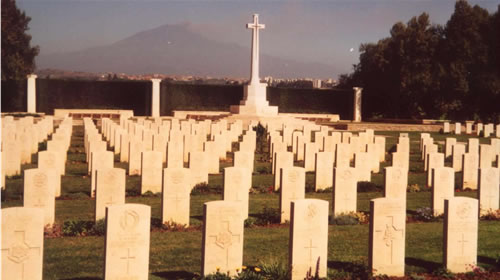Catania War Cemetery

The 1st Canadian Infantry Division and the 1st Canadian Army Tank Brigade (both part of General Montgomery's Eighth Army) sailed from the U.K.. in June 1943 and landed in the south of Sicily July 10 near Pachino, while their allies from the U.K.. and the U.S. landed to the east and west. Opposition was light and so there were few casualties - the majority of them British gliders brought down by strong winds and anti-aircraft fire (60 of 140 gliders landed in the sea). Resistance, however, would increase the deeper the Allies penetrated into Sicily.
Included among the Eighth Army's objectives was the port of Catania, along with the airfields in the plain of Catania. Fearing the loss of these strategic positions, the German and Italian command had concentrated their defences in the northeast corner of the island. Some of the fiercest fighting of the campaign then occurred along the coast at the Primosole Bridge over the Simeto, which was on the route to Catania for the 13th British Corps. The British 1st Parachute Brigade seized the bridge mid-July, but two days later relief troops from the British 50th Infantry Division found themselves facing a challenging counterattack. With the British were slowed on this front, it became more important to pressure the enemy on the Canadian front. The next week, the Canadians captured Leonforte and pushed on towards Nissoria, Agira, and Regalbuto. In the end, the 50th Infantry Division entered Catania unopposed on August 5th.
In Sicily the Allies' air forces assisted the campaign by raiding airfields, as well as the train ferry across the Strait of Messina and radar installations. As a result, reinforcement was next to impossible for the enemy, and the Allied ground troops were not bothered by enemy air forces. And, for the subsequent campaign on mainland Italy, the Allies now had an airbase from which to provide continued support.
Directions
The Catania War Cemetery is one of three Commonwealth war cemeteries in Sicily, along with Syracuse War Cemetery and Agira Canadian War Cemetery. The site is situated just southwest of Catania - a town several kilometres southeast of Agira. Looking north from the cemetery's location on the coastal plain in the Contrada Bicocca, the venerable volcano Mount Etna can be clearly viewed. Many of the war dead here were originally buried in battlefield cemeteries spreading from Lentini to Messina. They lost their lives during the latter part of the eastern campaign in Sicily - including the heavy fighting near Catania as well as the battle for the Simeto River bridgehead. Canadians did not participate in this action; the route of their drive was to the west. As well, they were for the most part withdrawn after capturing Agira and so did not fight in the final days of operation "Husky" - the campaign in Sicily. The cemetery contains 2,142 graves, the majority of them British and 113 of them unknown. However, there are 12 Canadian graves, containing the remains of 22 airmen - all members of the U.K. - although most of them were attached to Royal Air Force squadrons. There is also one Polish grave.
- Date modified: